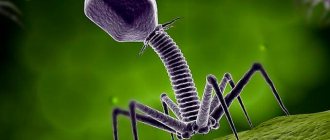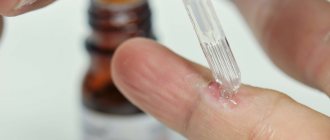Bacteriophage
In 1919, even before the discovery of penicillin, Felix D'Herelle discovered a completely different method of combating bacteria. But then he was never able to compete with antibiotics. We are talking about bacteriophage therapy.
Bacteriophages (phages) are viruses that use only prokaryotic cells to reproduce. These viruses are found everywhere in nature [6]. S. aureus was one of the first organisms used to demonstrate the existence of a bacteriophage [2].
In the 1920s–1940s, many studies were carried out on the clinical use of bacteriophages, but no consistent results were obtained. In the West, they began to abandon bacteriophage therapy [7].
The fight between Staphylococcus aureus and bacteriophage
Now phage preparations are mixtures of several bacteriophages. We will focus on one of the staphylococcal phages.
Phage 80α is a temperate lambda bacteriophage of the family Siphoviridae with a double-stranded DNA genome. 80α is capable of generalized transduction and may also act as a facilitator for the mobilization of SaPI pathogenicity islands [2], which have been shown to encode virulence factors such as toxic shock syndrome toxins and coagulase [1].
Like other bacteriophages, the 80α capsid assembles as an empty precursor, the procapsid. Handfuls of phage DNA are packaged into procapsids through the portal apex in an ATP-dependent process that requires small and large subunits of the terminase enzyme. DNA packaging is accompanied by expansion of the capsid and structural rearrangement of the shell.
For bacteriophage therapy, it is recommended to use those bacteriophages that follow the lytic path of development (with cell rupture).
Bacteriophage preparations
Now, with the development of modern methods of genetic engineering and molecular biology, bacteriophage therapy is coming to life in new research. And at the moment, bacteriophage therapy is used very carefully and strictly controlled, in order to avoid repeating the story with antibiotics.
However, such strict standards are not observed everywhere. In Western Europe, after the discovery of antibiotics, the use of bacteriophages was quickly abandoned. In Eastern Europe, despite the lack of large and well-controlled clinical trials, they remained a relatively popular treatment into the 20th century [8].
In the USSR, the study of bacteriophages continued. This led to the accumulation of a large collection of them in the countries of the post-Soviet space. Now, when Western countries are just beginning to take a closer look at bacteriophage therapy for the treatment of Staphylococcus aureus and prescribe them to a sick person in rare cases under the strict supervision of a doctor [9], in Russia bacteriophages are used quite actively as a medicine. And they can prescribe such drugs “lightly” despite the fact that their effectiveness has not been proven [10–16]: most Russian studies of bacteriophages are limited to 30–40 participants - such studies are not evidence-based. Unfortunately, such careless use of drugs can lead to an increase in bacterial resistance.
It is very important to treat bacteriophages with extreme caution. Otherwise, we will soon see the news “Bacteria are resistant to bacteriophage therapy.”
A little about VR
There is a part in the video where VR work is presented. To better understand what is where, please read the description below:
- For ease of viewing the internal processes occurring in a bacterial cell, the cell wall and cytoplasmic membrane are made transparent.
- In the virus reproduction cycle, one type of bacteriophage is considered. This is staphylococcal bacteriophage 80α (alpha).
- The processes of replication, translation and transcription are simplified, and for a better visualization of these processes they are slightly separated in space.
Bacteriophage Staphylococcal solution for internal, external and local use fl 20ml No. 4
Compound
The solution contains:
Active substance: antistaphylococcal bacteriophage,
Excipient: quinosol.
Pharmacokinetics
Staphylococcal bacteriophage is an immunobiological preparation, phage. Staphylococcal bacteriophage has the ability to specifically lyse staphylococcal bacteria isolated during purulent infections, incl. Staphylococcus aureus.
Indications for use
Staphylococcal bacteriophage is used for the treatment and prevention of purulent infections of the skin, mucous membranes, visceral organs caused by staphylococcal bacteria, as well as for dysbiosis:
- diseases of the ear, throat, nose, respiratory tract and lungs (sinusitis, otitis media, sore throat, pharyngitis, laryngitis, tracheitis, bronchitis, pneumonia, pleurisy),
- surgical infections (purulent wounds, infected burns, abscess, phlegmon, furuncle, carbuncle, hidradenitis, panaritium, infiltrated and abscessed staphylococcal sycosis, paraproctitis, mastitis, bursitis, tenosynovitis, osteomyelitis),
- urogenital pathology (urethritis, cystitis, pyelonephritis, colpitis, endometritis, salpingoophoritis),
- enteral pathology (gastroenterocolitis, cholecystitis, intestinal dysbiosis),
- generalized septic diseases,
- purulent-inflammatory diseases of newborns (omphalitis, gastroenterocolitis, sepsis),
- other diseases of staphylococcal etiology,
- prevention of purulent processes in newly infected wounds (abdominal and thoracic surgeries, street and industrial injuries, etc.), for the prevention of nosocomial infections for epidemic indications.
Contraindications
None.
Directions for use and doses
An important condition for effective phage therapy is the preliminary determination of the phage sensitivity of the pathogen (determination of the sensitivity to staphylococcal bacteriophage of strains isolated from the patient).
The staphylococcal bacteriophage is introduced into the source of infection. The duration of the course of treatment is 5-15 days. Doses and method of administration depend on the nature of the source of infection (locally in the form of irrigation, lotions and tamponing, intradermally, in the cavity - abdominal, pleural, articular, into the bladder through a catheter, per os and per rectum). In case of recurrent course of the disease, repeated courses of treatment are possible.
Locally in the form of irrigation, lotions and tamponing with liquid phage in an amount of up to 200 ml, taking into account the size of the affected area, or lubrication with ointment.
It is advisable to treat purulent-inflammatory diseases with localized lesions simultaneously both locally and through the mouth for 7-20 days.
For purulent-inflammatory diseases of the ear, throat, nose, staphylococcal bacteriophage is administered in a dose of 2-10 ml 1-3 times a day, used for rinsing, washing, instillation, administration of moistened turundas (leaving them for 1 hour).
For boils and carbuncles, liquid staphylococcal bacteriophage is injected directly into the lesion or under the base of the infiltrate, as well as around it. Injections are made daily, every other day, depending on the reaction, in successively increasing doses: for 1 injection - 0.5 ml, then 1 - 1.5 - 2 ml. A total of 3-5 injections are performed per treatment cycle.
For abscesses, staphylococcal bacteriophage is injected into the cavity of the lesion after puncture removal of pus. The amount of the administered drug should be slightly less than the volume of removed pus. When opening an abscess, a tampon richly moistened with staphylococcal bacteriophage is inserted into the cavity.
For chronic osteomyelitis, staphylococcal bacteriophage is infused into the wound immediately after surgical treatment.
To treat deep forms of pyodermatitis, staphylococcal bacteriophage is used intradermally in small doses of 0.1-0.5 ml in one place or, if necessary, up to 2 ml in several places. A total of 10 injections every 24 hours.
Introduction into cavities - abdominal, pleural, articular and others - up to 100 ml of bacteriophage. Capillary drainage is left, through which the bacteriophage is reintroduced every other day, a total of 3-4 times.
For cystitis, a staphylococcal bacteriophage is injected into the bladder cavity using a catheter.
For purulent pleurisy, bursitis or arthritis, staphylococcal bacteriophage is injected into the cavity after removing pus from it in an amount of up to 20 ml. and more, every other day, 3-4 times.
Orally in the form of tablets, staphylococcal bacteriophage is used to treat urogenital infectious pathologies - cystitis, pyelitis, pyelonephritis, endometritis, salpingoophoritis, enteral infections and other diseases caused by staphylococcal bacteria.
For intestinal forms of the disease caused by staphylococcus and intestinal dysbiosis, liquid staphylococcal bacteriophage is used: orally 3 times a day on an empty stomach 1.5-2 hours before meals, rectally - once a day (liquid in the form of enemas or suppositories). For intestinal dysbiosis, treatment is carried out for 7-10 days under bacteriological control. For children in the first days of life, in the first two doses, the staphylococcal bacteriophage is diluted with boiled water 2 times. In the absence of adverse reactions (regurgitation, skin rash), the undiluted drug is subsequently used. In this case, it can be mixed with breast milk.
For sepsis and enterocolitis in newborns, including premature babies, staphylococcal bacteriophage is used in the form of high enemas (through a gas tube or catheter) 2-3 times a day. A combination of rectal (in enemas) and oral (by mouth) use of the drug is possible.
In the treatment of omphalitis, pyoderma, and infected wounds in newborns, staphylococcal bacteriophage is used in the form of applications twice daily (a gauze cloth is moistened with staphylococcal bacteriophage and applied to the umbilical wound or the affected area of the skin).
Recommended dosage of Staphylococcal Bacteriophage:
Age Dose for 1 dose Orally liquid / tablets In enema (ml.) In suppositories Up to 6 months 5-10 ml 200.5 From 6 to 12 months 10-15 ml 200.5 From 1 year to 3 years 15-20 ml / 0.5-1 tablets 401 from 3 up to 8 years 20-50 ml / 1 tablet 40-1001 From 8 years and older 20-50 ml / 2 tablets 40-1001 Frequency of taking liquid drug - 2-3 times a day, tablets 3-4 times a day. Liniment is used topically for tamponing and dressings, 5-20 g depending on the area of the lesion, 1-2 times a day for dressings.
Staphylococcal bacteriophage is used for prophylaxis in an amount of 50 ml. for irrigation of postoperative wounds, etc.
In order to prevent sepsis and enterocolitis in newborns with intrauterine infection or the risk of nosocomial infection, staphylococcal bacteriophage is used in the form of enemas 2 times a day for 5-7 days.
Staphylococcal bacteriophage in aerosol form is used for therapeutic and prophylactic purposes in the form of irrigation of staphylococcus-infected skin and mucous membranes for burns, purulent-inflammatory diseases, infected wounds, and sore throat.
The most appropriate use of bacteriophage is in cases where the infection is caused by antibiotic-resistant strains. Combination treatment with staphylococcal bacteriophage in combination with antibiotics can be carried out.
If chemical antiseptics other than furatsilin were used before topical application of the staphylococcal bacteriophage, the wound should be washed with physiological sodium chloride solution or 2-3% soda solution (sodium bicarbonate).
Storage conditions
In a dry place, protected from light, at a temperature of 28 C
Best before date
2 years
special instructions
Liquid staphylococcal bacteriophage is not suitable for use if it is cloudy or has flakes. Use during pregnancy is possible as prescribed by a doctor, subject to dosage.
Conditions for dispensing from pharmacies
Available with prescription
Side effects
Not installed.
Interaction
The use of staphylococcal bacteriophage does not exclude the use of other drugs. It is possible to carry out combined treatment with staphylococcal bacteriophage in combination with antibiotics.
Staphylococcus aureus
Staphylococci are gram-positive and non-spore-forming cocci that form pairs, short chains or clusters. The genus Staphylococcus contains many species that are separated from each other based on the production of the enzyme coagulase [1].
Staphylococcus aureus (Staphylococcus aureus) is a coagulase-positive species and is one of the most virulent species.
Virulence (from Latin virulentus - “poisonous”) the degree of ability of an infectious agent (strain of microorganism or virus) to cause disease or death of the body.
Staphylococcus aureus is an often harmless inhabitant of the epithelium of human skin and mucous membranes, but is also associated with serious systemic and local infections [2] and is one of the most common causes of foodborne infections worldwide. S. aureus produces 15 enterotoxins.
Enterotoxins are bacterial toxins that cause the secretion of fluid from intestinal cells.
Fighting Staphylococcus aureus
The fight against bacteria has been going on for a long time. People have tried to treat wounds with plants. And by trial and error, the necessary antimicrobial drugs were selected [3].
However, the real fight against bacteria began with the discovery of penicillin by Alexander Fleming in 1928. And already in 1929, Fleming’s article was published in the British Journal of Experimental Pathology. Although penicillin had already been “discovered” several times before Fleming, scientists of that time only wrote reports, took notes, but did not publish the results in scientific journals [4]. The open mushroom killed staphylo- and streptococci and even diphtheria bacillus [5].
Already in 1940, the first information about bacterial resistance to penicillin appeared.
Competition “Bio/Mol/Text”-2020/2021
This work was published in the nomination “Visually about the beloved” of the competition “Bio/Mol/Text”-2020/2021.
The general partner of the competition is the annual biotechnology conference BiotechClub, organized by the international innovative biotechnology company BIOCAD.
The sponsor of the competition is SkyGen: a leading distributor of life science products on the Russian market.
Competition sponsor: the largest supplier of equipment, reagents and consumables for biological research and production.
"Book" sponsor of the competition - "Alpina Non-Fiction"




